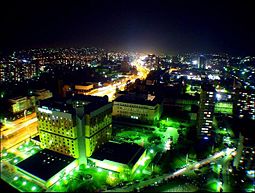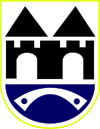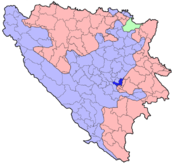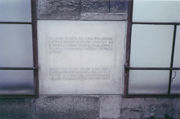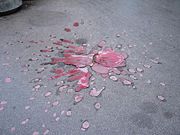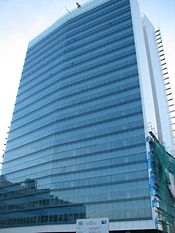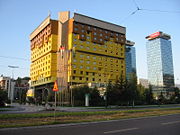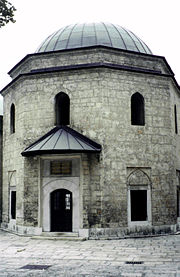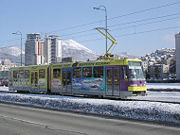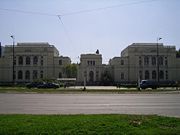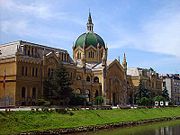Sarajevo
2008/9 Schools Wikipedia Selection. Related subjects: Europe; European Cities
| Sarajevo Сарајево |
|||
| Downtown Sarajevo at night | |||
|
|||
| Bosnia and Herzegovina surrounding Sarajevo (dark blue, centre) | |||
| Coordinates: | |||
|---|---|---|---|
| Country | Bosnia and Herzegovina | ||
| Entity | Federation of Bosnia and Herzegovina | ||
| Canton | Sarajevo Canton | ||
| Government | |||
| - Mayor | Semiha Borovac ( SDA) | ||
| Area | |||
| - Total | 141.5 km² (54.6 sq mi) | ||
| Elevation | 500 m (1,640 ft) | ||
| Population (Dec 2006 est.) | |||
| - Total | 419,030 ( Sarajevo Canton) | ||
| - Density | 2,149/km² (5,565.9/sq mi) | ||
| Time zone | Central European Time ( UTC+1) | ||
| Area code(s) | +387 (33) | ||
| Website: City of Sarajevo | |||
Sarajevo is the capital city and largest urban centre of Bosnia and Herzegovina, with an estimated total population of 419,030 people in the Sarajevo Canton as of June 2007. It is also the capital of the Federation of Bosnia and Herzegovina entity, and the de jure capital of the Republika Srpska entity, as well as the centre of the Sarajevo Canton. Sarajevo is located in the Sarajevo valley of Bosnia proper, surrounded by the Dinaric Alps and situated around the Miljacka river. The city is famous for its traditional religious diversity, with adherents of Islam, Orthodoxy, Catholicism and Judaism peacefully coexisting there for centuries.
Although settlement in the area stretches back to prehistoric times, the modern city arose as an Ottoman stronghold in the 15th century. Sarajevo has attracted international attention several times throughout its history: In 1914 it was the site of the assassination that sparked World War I, while seventy years later it became the host city of the 1984 Winter Olympics. More recently, Sarajevo underwent the longest siege in modern military history during the Bosnian War. Today the city is recovering and adjusting to a post-war reality, as a major centre of culture and economic development in Bosnia and Herzegovina. Sarajevo was also the first city in Europe and the second city in the world to have a full-time operational electric tram network running through the city, the first being San Francisco.
Geography and climate
Geography
Sarajevo is located at , near the geometric centre of the triangular-shaped Bosnia-Herzegovina and within the historical region of Bosnia proper. It lies in the Sarajevo valley, in the middle of the Dinaric Alps. The valley itself once formed a vast expanse of greenery, but gave way to urban expansion and development in the post-World War II era. The city is surrounded by heavily forested hills and five major mountains. The highest of the surrounding peaks is Treskavica at 2,088 meters (6,850 ft), then Bjelasnica at 2,067 meters (6,781 ft), Jahorina at 1,913 meters (6,276 ft), Trebevic at 1,627 meters (5,338 ft), with 1,502 meters (4,928 ft) Igman being the shortest. Last four are also known as Olympics mountains of Sarajevo (see also 1984 Winter Olympics Games in Sarajevo). On average, Sarajevo is situated 500 meters (1,640 ft) above sea level. The city itself has its fair share of hilly terrain, as evidenced by the many steeply inclined streets and settlements seemingly perched on the hillsides.
The Miljacka river is one of the city's chief geographic features. It flows through the city from east through the centre of Sarajevo to west part of city where eventually meets up with the Bosna river. Miljacka river is "The Sarajevo River", with its source in the town of Pale, several kilometers to the east of Sarajevo. The Bosna's source, Vrelo Bosne near Ilidža (west Sarajevo), is another notable natural landmark and a popular destination for Sarajevans and other tourists. Several smaller rivers and streams also run through the city and its vicinity.
Cityscape
Sarajevo is located close to the centre of the triangular shape of Bosnia and Herzegovina in southeastern Europe. It consists of four municipalities (or "Općina"): Centar (Centre), Novi Grad (New City), Novo Sarajevo (New Sarajevo), and Stari Grad (Old City). Greater Sarajevo includes these and the neighbouring municipalities of Ilidža and Vogošća. The city has an urban area of 141.5 square kilometres (54.6 sq mi)
Climate
Sarajevo has a mild continental climate, lying between the climate zones of central Europe to the north and the Mediterranean to the south. The average yearly temperature is 9.5 ° C, with January (-1.3 °C avg.) being the coldest month of the year and July (19.1 °C avg.) the warmest. The highest recorded temperature was 40.0 °C on August 19, 1946, while the lowest recorded temperature was −26.4 °C on January 25, 1942. On average, Sarajevo has 68 summer days per year (temperature greater than or equal to 30.0 °C). The city typically experiences mildly cloudy skies, with an average yearly cloud cover of 59%. The cloudiest month is December (75% average cloud cover) while the clearest is August (37%). Moderate precipitation occurs fairly consistently throughout the year, with an average 170 days of rainfall. Suitable climatic conditions have allowed winter sports to flourish in the region, as exemplified by the Winter Olympics in 1984 that were celebrated in Sarajevo.
| Weather averages for Sarajevo, Bosnia and Herzegovina | |||||||||||||
|---|---|---|---|---|---|---|---|---|---|---|---|---|---|
| Month | Jan | Feb | Mar | Apr | May | Jun | Jul | Aug | Sep | Oct | Nov | Dec | Year |
| Average high °C | 3 | 5 | 12 | 16 | 22 | 25 | 27 | 28 | 20 | 18 | 10 | 4 | 18 |
| Average low °C | -3 | -2 | 2 | 5 | 9 | 12 | 14 | 14 | 10 | 8 | 4 | -1 | 6 |
| Precipitation mm | 51.6 | 55.3 | 36.7 | 67.4 | 68.5 | 72 | 79 | 58.2 | 113.4 | 72.6 | 80.7 | 69.9 | 825.3 |
| Average high °F | 37 | 41 | 53 | 61 | 71 | 77 | 81 | 82 | 69 | 64 | 51 | 39 | 60 |
| Average low °F | 26 | 28 | 35 | 41 | 49 | 54 | 58 | 57 | 50 | 46 | 39 | 29 | 42 |
| Precipitation inches | 2.03 | 2.18 | 1.44 | 2.65 | 2.7 | 2.83 | 3.11 | 2.29 | 4.46 | 2.86 | 3.18 | 2.75 | 32.48 |
| Source: MSN 2007-03-05 | |||||||||||||
History
The Sarajevo valley has a long and rich history dating back to the Neolithic period, when the Butmir Culture flourished. Several Illyrian settlements existed in the area before it was conquered by Rome in 9 CE. During Roman times, a town named Aquae Sulphurae ("sulfuric thermal spring") existed on the location of the present-day Sarajevo suburb of Ilidža. After the Romans, the Goths settled the area, followed by the Slavs in the 7th century. The settlement Vrh-Bosna existed in the valley as a Slavic citadel from 1263 until it was conquered by the Ottoman Empire's warriors in 1429. Under Isa-Beg Isaković, the first Ottoman governor of the Bosnia Province, the settlement was established as a city, named Bosna-Saraj, around the citadel in 1461. The name Sarajevo is derived from Turkish saray ovası, meaning the field around saray.
The governor oversaw the construction of the city's Old Town district, including a water-supply system, mosque, closed marketplace, public bath, hostel, and Governor's palace. Gazi Husrev-beg was appointed the second governor of the Bosnia Province in 1521 and built the city's first library, madrassa, school of Sufi philosophy, as well as the Sahat Kula clock tower.
In 1697, during the Great Turkish War, a raid was led by Prince Eugene of Savoy of the Habsburg Monarchy against the Ottoman Empire, which conquered Sarajevo and left it plague-infected and burned to the ground. The city was later rebuilt, but never fully recovered from the destruction. The Ottoman Empire made Sarajevo an important administrative centre by 1850, but the ruling powers changed as the Austria-Hungarian Empire conquered Bosnia and Herzegovina in 1878 as part of the Treaty of Berlin, and annexed it completely in 1908. Sarajevo was industrialized by Austria-Hungary, who used the city as a testing area for new inventions, such as tramways, before installing them in Vienna. In the event that triggered World War I, Archduke Franz Ferdinand of Austria and his wife Sophie, Duchess of Hohenberg, were assassinated in Sarajevo on June 28, 1914 by a Serb, Gavrilo Princip, a nationalist/provocateur assassin. In the ensuing war, however, most of the Balkan offensives occurred near Belgrade, and Sarajevo largely escaped damage and destruction during the war. Following the war, after the Balkans were unified under the Kingdom of Yugoslavia, Sarajevo became the capital of the Drina Province.
In April 1941 Nazi Germany invaded Yugoslavia and bombarded Sarajevo. At this time, there were approximately 10,500 Jews living in Sarajevo, who, along with Romany and Orthodox Serbians, were oppressed by the Croatian Ustaše government (which some of the Muslim population was part of) or transported to concentration camps. Yugoslav Partisan resistance fighters, led by Josip Broz Tito, liberated Sarajevo on 6 April 1945.
Afterwards, the city grew rapidly as it became an important regional industrial centre in Yugoslavia. As part of the 1945 General Town Development Plan modern city blocks were built west of the old city, adding to Sarajevo's architectural diversity. The peak of city growth occurred in the early 1980s, when Sarajevo hosted the 1984 Winter Olympics.
The Siege of Sarajevo was the longest siege in the history of modern warfare, conducted by the Serb forces of self-proclaimed Republika Srpska and Yugoslav People's Army (later transformed to the Army of Serbia and Montenegro), lasting from April 5, 1992 to February 29, 1996.
It was fought during the Bosnian War between poorly equipped defending forces of the Bosnian government, who had declared independence from Yugoslavia, and the Yugoslav People's Army (JNA) and Bosnian Serb forces ( Army of Republika Srpska) (VRS) located in the hills around Sarajevo, who sought to destroy the newly-independent state of Bosnia and Herzegovina and create the Serbian state of Republika Srpska (RS). It resulted in large scale destruction and dramatic population casualties. It is estimated that of the more than 12,000 people who were killed and the 50,000 who were wounded during the siege, 85% of the casualties were civilians. Because of killing and forced migration, by 1995 the population decreased to 334,663 - 64% of the prewar population.
In January 2003, the ICTY Trial Chamber convicted the first commander of the Sarajevo-Romanija Corps, Stanislav Galić, of the shelling and sniper terror campaign against Sarajevo, including the first Markale massacre. General Galić was sentenced to life imprisonment for the crimes against humanity during the siege. In 2007, a Serb general, Dragomir Milošević, who replaced Stanislav Galić on the commander position of the Sarajevo-Romanija Corps, was found guilty of the shelling and sniper terror campaign against Sarajevo and its citizens from August 1994 to late 1995 including the second Markale massacre. Milošević was sentenced to 33 years in prison. The Trial Chamber concluded that the Markale town market was hit on August 28, 1995 by a 120mm mortar shell fired from the Sarajevo-Romanija Corps positions.
Reconstruction of Sarajevo started as soon as the war ended with the Dayton Agreement of November 1995.
By 2003, most of the city had been rebuilt or repaired, with only a few remaining visible ruins in the city centre. Many of the WWII shell casings that were used during the attacks have been carved and polished in Sarajevo tradition and are sold as art. American actor Terrance Howard has collected such casings and has pointed out the parallels to the scripture in Isaiah 2:4 about turning swords into plowshares. Modern office buildings and skyscrapers have since been constructed throughout the city.
Government
Sarajevo is the capital of the country of Bosnia and Herzegovina and its sub-entity, the Federation of Bosnia and Herzegovina, as well as of the Sarajevo Canton. It is also the de jure capital of another entity, Republika Srpska. Each of these levels of government has their parliament or council, as well as judicial courts, in the city. In addition many foreign embassies are located in Sarajevo.
The city comprises four municipalities which each operate their own municipal government, united to form one city government with its own constitution. The executive branch ( Bosnian: "Gradska Uprava") consists of a mayor, with two deputies and a cabinet. The legislative branch consists of the City Council, or Gradsko Vijeće. The council has 28 members, including a council speaker, two deputies, and a secretary. Councillors are elected by the municipality in numbers roughly proportional to their population. The city government also has a judicial branch based on the post-transitional judicial system as outlined by the High Representative's “High Judicial and Prosecutorial Councils”.
Sarajevo's Municipalities are further split into "local communities" (Bosnian, Mjesne zajednice). Local communities have a small role in city government and are intended as a way for ordinary citizens to get involved in city government. They are based around key neighborhoods in the city.
Bosnia and Herzegovina's Parliament office in Sarajevo was damaged heavily in the Bosnian war. Due to damage the staff and documents were moved to a nearby ground level office to resume the work. In late 2006 reconstruction work started on the Parliament and is to be finished in early 2007. The cost of reconstruction is supported 80% by the Greek Government through the Hellenic Program of Balkans Reconstruction (ESOAV) and 20% by Bosnia-Herzegovina.
Economy
After years of war, Sarajevo's economy has been subject to reconstruction and rehabilitation programs. Amongst other economic landmarks, the Central Bank of Bosnia and Herzegovina opened in Sarajevo in 1997 and the Sarajevo Stock Exchange began trading in 2002. The city's large manufacturing, administration, and tourism base, combined with a large informal market, makes it one of the strongest economic regions of Bosnia and Herzegovina.
While Sarajevo had a large industrial base during its communist period, only a few pre-existing businesses have successfully adapted to the market economy. Sarajevo industries now include tobacco products, furniture, hosiery, automobiles, and communication equipment. Companies based in Sarajevo include B&H Airlines (Formerly Air Bosna), BH Telecom, Bosmal City Centre, Bosnalijek, Energopetrol, Sarajevo Tobacco Factory, and Sarajevska Pivara (Sarajevo Brewery).
Sarajevo has a strong tourist industry and was named by Lonely Planet the 43rd Best City in the World in 2006. Sports-related tourism uses the legacy facilities of the 1984 Winter Olympics, especially the skiing facilities on the nearby mountains of Bjelašnica, Igman, Jahorina, Trebević, and Treskavica. Sarajevo's 600 years of history, influenced by both Western and Eastern empires, is also a strong tourist attraction. Sarajevo has hosted travellers for centuries, because it was an important trading centre during the Ottoman and Austria-Hungarian empires. Examples of popular destinations in Sarajevo include the Vrelo Bosne park, the Sarajevo cathedral, and the Gazi Husrev-beg's Mosque.
Tourism. Lonely Planet, in ranking the best cities in the world, ranked Sarajevo, the national capital and host of the 1984 Winter Olympic Games, as #43, ahead of Dubrovnik at #59, Ljubljana at #84, Bled at #90, Belgrade at #113, and Zagreb at #135. Tourism in Sarajevo is chiefly focused on historical, religious, and cultural aspects
Demographics
The last official census in Bosnia and Herzegovina took place 1991 which recorded 527,049 people living in city of Sarajevo (ten municipalities). In settlement of Sarajevo itself was 416,497 inhabitants. The war displaced hundreds of thousands of people, many of whom have not returned. As of 2006 the Sarajevo Canton government estimated the population at 418,891 people (304,136 in City of Sarajevo, the rest in metropolitan area). With an area of 493 square miles (1,280 km²), Sarajevo has a population density of about 2173 people per square kilometer. The Novo Sarajevo municipality is the most densely populated part of Sarajevo with about 7524 inhabitants per square kilometer, while the least densely populated is the Stari Grad, with 742 inhabitants per square kilometer.
War changed the ethnic and religious profile of the city. While it had long been known as a multicultural city, or Europe's Jerusalem, Muslims Bosniaks returned to form an even greater proportion of the population. In 1991 Bosniaks formed 45% of the population, followed by Eastern Orthodox Serbs with 38%, and Roman Catholic Croats with 7%. However, in 1997 Bosniaks formed 87% of the population, with Serbs at 5% and Croats at 6%. If the East Sarajevo ( Republika Srpska) population were to be included (130,000, mostly Serbs), the Bosniaks would still have an absolute majority, followed by Serbs at around 33% of the overall population.
Today, Sarajevo's population is not known clearly and is based of estimates contributed by the United Nations Statistics Division and the Federal Office of Statistics, Federation of Bosnia and Herzegovina among other national and international non-profit organizations. It is believed that Sarajevo’s population to date has actually increased rather than decreased due to many migrants moving from rural villages destroyed during the Bosnian war.
Sarajevo is currently undergoing a large scale building boom as new commercial, industrial, residential, and office buildings and facilities are under construction. The city is growing at a fast pace and will retain its prewar population within a period of 10-20 years. Because of its large growth, many new Apartment buildings have been constructed in Sarajevo; specifically in the Eastern suburb of Ilidža. The city is also renovating its sports facilities; such as its main stadium, and its well known skiing hotels and venues. The construction of Highway 5C will further supplement and boost Sarajevo's already impressive growth.
Transportation
Sarajevo's location in a valley between mountains makes it a compact city. Narrow city streets and a lack of parking areas restrict automobile traffic but allow better pedestrian and cyclist mobility. The two main streets are Titova street (Street of Marshal Tito) and the east-west Zmaj od Bosne (Dragon of Bosnia) highway. The trans-European highway, Corridor 5C, runs through Sarajevo connecting it to Budapest in the north, and Ploče in the south.
Electric tramways, in operation since 1885, are the oldest form of public transportation in the city. There are seven tramway lines supplemented by five trolleybus lines and numerous bus routes. The main railroad station in Sarajevo is located in the north-central area of the city. From there, the tracks head west before branching off in different directions, including to industrial zones in the city. Sarajevo is currently undergoing a major infrastructure renewal; many highways and streets are being repaved, the tram system is undergoing modernization, and new bridges and roads are under construction.
Sarajevo International Airport ( IATA: SJJ), also called Butmir, is located just a few kilometers southwest of the city. During the war the airport was used for United Nations flights and humanitarian relief. Since the Dayton Accord in 1996, the airport has welcomed a thriving commercial flight business which includes the new Sarajevo International on March 2008 221 Countries, cities and airlines. In 2006, 534,000 passengers had travelled through Sarajevo airport, whereas only 25,000 had just 10 years earlier in 1996.
Culture
Sarajevo has been home to many different religions for centuries, giving the city a range of diverse cultures. Bosnian Muslims, Orthodox, Catholics and Jews all shared the city while maintaining distinctive identities. Today, however, the city is overwhelmingly Bosnian Muslim, but in recent years many returnees have been noticed as well as a growing number of foreigners from Eastern Asia.
The city is rich in museums, including the Museum of Sarajevo, the Ars Aevi Museum of Contemporary Art, the National Museum of Bosnia and Herzegovina (established in 1888 and home to the Sarajevo Haggadah), the Historical Museum of Bosnia and Herzegovina, and the Museum of Literature and Theatre Arts of Bosnia and Herzegovina. The city also hosts the National theatre of Bosnia and Herzegovina, established in 1919, as well as the Sarajevo Youth Theatre. Other cultural institutions include the Centre for Sarajevo Culture, Sarajevo City Library, Art Gallery of Bosnia and Herzegovina, and the Bosniak Institute, a privately owned library and art collection focusing on Bosniak history.
Demolitions associated with the war, as well as reconstruction, destroyed several institutions and cultural or religious symbols including the Gazi Husrev-beg library, the national library, the Sarajevo Oriental Institute, and a museum dedicated to the 1984 Olympic games. Consequently, the different levels of government established strong cultural protection laws and institutions. Bodies charged with cultural preservation in Sarajevo include the Institute for the Protection of the Cultural, Historical and Natural Heritage of Bosnia and Herzegovina (and their Sarajevo Canton counterpart), and the Bosnia and Herzegovina Commission to Preserve National Monuments.
Historically, Sarajevo was home to several famous Bosnian poets and thinkers during the Ottoman Empire. Nobel Prize winner Vladimir Prelog is from the city, as was academy award winning director Danis Tanović. Nobel Prize winner Ivo Andrić spent much of his life in Sarajevo.
The Sarajevo Film Festival, established in 1995, has become the premier film festival in the Balkans. The Sarajevo Winter Festival, Sarajevo Jazz Festival are well-known, as are the Baščaršija Nights, a month-long showcase of local culture, music, and dance.
The Sarajevo school of pop rock developed in the city between 1961 and 1991. This type of music began with bands like Indexi, Bijelo dugme and singer/song writer Kemal Monteno. It continued into the 1980s, with bands such as Plavi orkestar, Zabranjeno pušenje and Crvena jabuka, ending with the war in 1992. After the war, Irish rock band U2 was the first band to play in the city live.
Festivals
Sarajevo is regionally renowned for its Sarajevo Film Festival (SFF) and its Sarajevo Jazz Festival.
The SFF has been hosted in Sarajevo at the National Theater in the centre of Sarajevo and has hosted such world-renowned actors, directors, and musicians as: Steve Buscemi, Bono, Coolio, John Malkovich, Nick Nolte, Daniel Craig, Willem Dafoe, Anthony Minghella, Katrin Cartlidge, Alexander Payne, Sophie Okonedo, Stephen Frears, to name a few.
For the past twelve years, the festival has entertained people and celebrities alike, elevating it to an international level. The first incarnation of the Sarajevo Film Festival was hosted in still-warring Sarajevo in 1995, and has progressed into a classy representation of what Sarajevo can really be. 13th Sarajevo Film Festival hosted Juliette Binoche, Jeremy Irons, Steve Buscemi, and Michael Moore as its principal jurors.
The Sarajevo Jazz Festival has been entertaining Jazz connoisseurs (locals and expats) for ten years now and has hosted such greats as: Richard Bona, The John Butler Trio, Cristina Branco, Dhafer Youssef, and many more. The festival takes place at the Bosnian Cultural Center (aka "Main Stage"), just down the street from the SFF, at the Sarajevo Youth Stage Theatre (aka "Strange Fruits Stage", at the Dom Vojske Federacije (aka "Solo Stage"), and at the CDA (aka "Groove Stage").
Sports
The city was the location of the 1984 Winter Olympics. Yugoslavia won one medal, a silver in men's giant slalom awarded to Jure Franko. Many of the Olympic facilities survived the war or were reconstructed, including Olympic Hall Zetra and Asim Ferhatović Stadion. After co-hosting the Southeast Europe Friendship games, Sarajevo was awarded the 2009 Special Olympic winter games, but cancelled these plans.
Football (soccer) is popular in Sarajevo; the city hosts FK Sarajevo and FK Željezničar, which both compete in European and international cups and tournaments, as well as FK Olimpik and SAŠK. Another popular sport is basketball; the basketball club KK Bosna Sarajevo won the European Championship in 1979. The chess club, Bosna Sarajevo, has been a championship team since the 1980s. Sarajevo often holds international events and competitions in sports such as tennis and kickboxing. Rock climbing is popular; not far from the CBD is the sport climbing crag, Dariva Sarajevo International Speedway on January 2009
| Club | Leagues | Venue | Established |
|---|---|---|---|
| FK Željezničar Sarajevo | Premier League of Bosnia and Herzegovina Football Association of Bosnia and Herzegovina |
Grbavica Stadium | 1921 |
| FK Sarajevo | Premier League of Bosnia and Herzegovina Football Association of Bosnia and Herzegovina |
Asim Ferhatović Hase Stadium | 1946 |
| FK Olimpik Sarajevo | Football Association of Bosnia and Herzegovina Second League of the Federation of Bosnia and Herzegovina |
Otoka Stadium | 1993 |
| KK Bosna | Premier League of Basketball of Bosnia and Herzegovina Adriatic Basketball Association |
Mirza Delibašić Arena | 1951 |
Education
Higher education has a long tradition in Sarajevo. The first institution that can be classified as such was a school of Sufi philosophy established by Gazi Husrev-beg in 1531; numerous other religious schools have been established over time. In 1887, under the Austro-Hungarian Empire, a Sharia Law School began a five-year program. In the 1940s the University of Sarajevo became the city's first secular higher education institute. In the 1950s post-bachelaurate graduate degrees became available. While severely damaged during the war, it was rebuilt in partnership with more than 40 other universities.
As of 2005, in Sarajevo there are 46 elementary schools (Grades 1–9) and 33 high schools (Grades 10–13), including three schools for children with special needs , as well as Druga Gimnazija high school providing International Baccalaureate programs for international and resident students.
There are also several international schools in Sarajevo, catering to the expatriate community; some of which are QSI International School of Sarajevo and The French International School of Sarajevo.
Sarajevo in Popular Culture
- In the long-time RTS series Command & Conquer, the Brotherhood of Nod often builds its centre of operations at Sarajevo. Kane's temple, Temple Prime, is built near the outskirts of the city.
- * Sarajevo was used as the primary filming location in Welcome to Sarajevo and The Hunting Party, starring Woody Harrelson and Richard Gere, respectively.
Twin cities
|
|
Videos
- http://www.youtube.com/watch?v=tnaG0PiBPbw -- Al-Jazeera's Special "Veterans of Sarajevo" (Part One)
- http://www.youtube.com/watch?v=lGhexbsIxVg&feature=related -- Al-Jazeera's Special "Veterans of Sarajevo" (Part Two)
- http://www.youtube.com/watch?v=1vHRwmFc-1o -- Trans-Siberian Orchestra - Christmas Eve Sarajevo
- http://www.youtube.com/watch?v=7jQ35dYGcX8 -- Fan Video dedicated to Sarajevo
